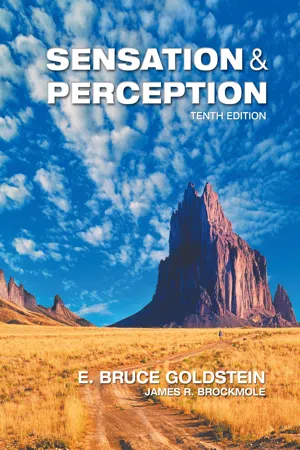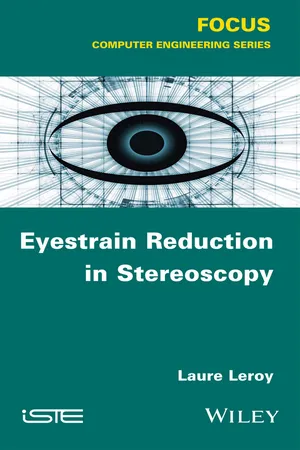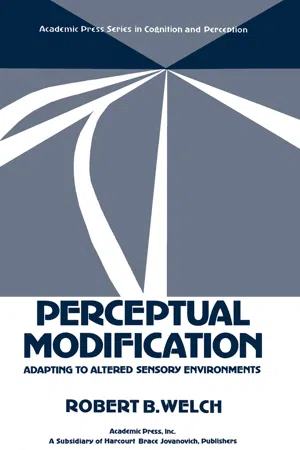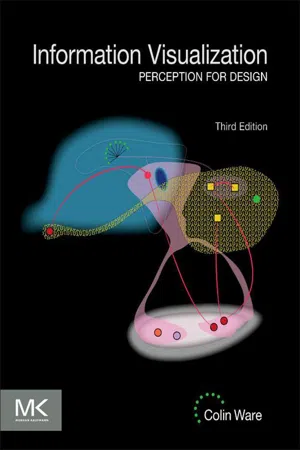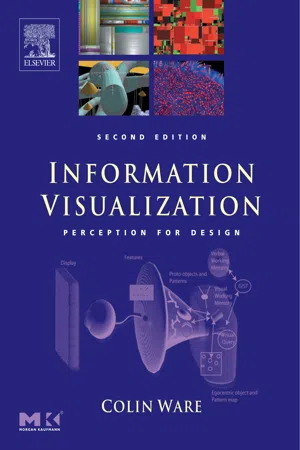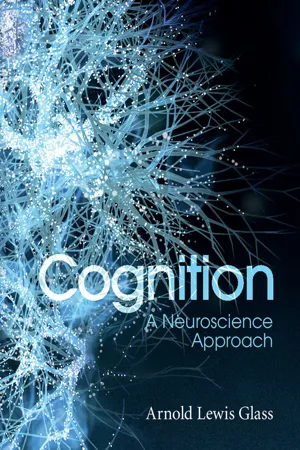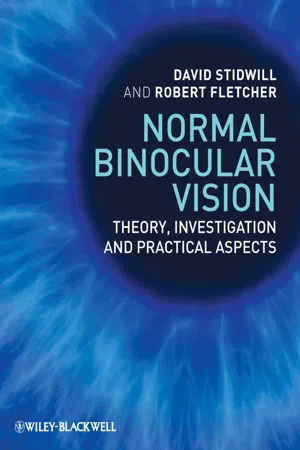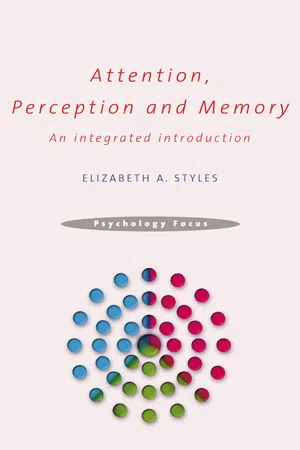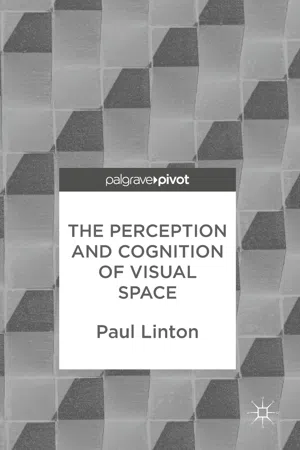Psychology
Depth Cues Psychology
Depth cues in psychology refer to the visual cues that help us perceive depth and distance in our environment. These cues can be monocular, such as relative size and linear perspective, or binocular, such as retinal disparity and convergence. Understanding depth cues is important for our ability to navigate and interact with the world around us.
Written by Perlego with AI-assistance
Related key terms
1 of 5
10 Key excerpts on "Depth Cues Psychology"
- eBook - PDF
- E. Goldstein, James Brockmole(Authors)
- 2016(Publication Date)
- Cengage Learning EMEA(Publisher)
After this learning has occurred, the association between particular cues and depth becomes automatic, and when these depth cues are present, we experience the world in three dimen- sions. A number of different types of cues that signal depth in a scene have been identified. We can divide these cues into three major groups: 1. Oculomotor. Cues based on our ability to sense the position of our eyes and the tension in our eye muscles. 2. Monocular. Cues based on the visual information available within one eye. 3. Binocular. Cues that depend on visual information within both eyes. Oculomotor Cues The oculomotor cues are created by (1) convergence, the inward movement of the eyes that occurs when we look at nearby objects, and (2) accommodation, the change in the shape of the lens that occurs when we focus on objects at vari- ous distances. The idea behind these cues is that we can feel the inward movement of the eyes that occurs when the eyes converge to look at nearby objects, and we feel the tightening of eye muscles that change the shape of the lens to focus on a nearby object. You can experience the feelings in your eyes associated with convergence and accommodation by doing the following demonstration. T H' H T H (a) Eye and scene (b) Image of scene on retina T' Figure 10.2 (a) In the scene, the house is farther away than the tree, but images of points H on the house and T on the tree fall on points H’ and T’ on the two-dimensional surface of the retina on the back of the eye. (b) These two points on the retinal image, considered by themselves, do not tell us the distances of the house and the tree. (a) (b) Figure 10.1 (a) Misperception of the man’s depth leads to an incorrect perception of his size. (b) When the illusion of the “chair” is removed, the man’s actual depth can be determined, and he appears to be taller. Dr. Peter Thompson Copyright 2017 Cengage Learning. All Rights Reserved. May not be copied, scanned, or duplicated, in whole or in part. - eBook - ePub
- Laure Leroy(Author)
- 2016(Publication Date)
- Wiley-ISTE(Publisher)
Monocular cues are all those visual cues perceptible with a single eye. You do not need three-dimensional (3D) glasses to understand that, in the key scene of your favorite film, the heroes are standing in front of the background. Similarly, when you look at a photo you see immediately that such-and-such an object is closer to the lens than such-and-such a person, and vice versa. You are capable of making these deductions due to monocular depth cues.We must not overlook the influence of these cues in our perception of depth. Indeed, it is estimated that between 3 and 10% of the population do not use stereopsis in their day-to-day vision. You might be one of them without even knowing it. Your depth vision would be based only on monocular cues. Also note that these cues are so strong that, when monocular and binocular cues conflict, your brain will follow the monocular cues.1.2.1.1. Static monocular cues
Among the monocular or monoscopic cues, there are the static cues: shadows, superposition, perspective, apparent size of objects, variation of texture, etc. We use these cues when we look at a photo or a drawing or any other fixed image.1.2.1.1.1. Light and shadows
Through its reflection on surfaces, light will influence the perception of the orientation of planes and the distance between these and the light source.Figure 1.2.Light and shadows completely change depth perception1.2.1.1.2. Interposition
When an object partially hides another, the brain interprets the hidden part of the object as being further away than the object that hides it.Figure 1.3 . Interposition between a rectangle and an ellipse. The brain interprets the rectangle as being behind the ellipseThus, in Figure 1.3 , we see an ellipse in front of a rectangle. Note that we perceive a rectangle, part of which is hidden, whereas we might have equally seen a shape with one concave edge, next to an ellipse. But it is easier to perceive a shape with symmetries than a shape with no symmetry.1.2.1.1.3. Relative size
When objects produce a smaller retinal image when they are supposed to be of the same type, we interpret this difference as being due to the fact that the objects with a smaller retinal image are further away. Thus, in Figure 1.4 - eBook - PDF
Perceptual Modification
Adapting to Altered Sensory Environments
- Robert B. Welch, Edward C. Carterette, Morton P. Friedman(Authors)
- 2013(Publication Date)
- Academic Press(Publisher)
180 Adaptation to Distortions of Depth, Distance, and Size length and orientation of the edges of the image. Other monocular depth cues are linear perspective, texture gradient, and attached shadow (see Rock, 1975, Chapter 3, for a detailed discussion of these and other cues of depth and distance). Distance perception involves the assessment of how far away an object is from the observer. In contrast to depth perception, it involves a judgment of absolute location along the third dimension. Several cues for the perception of distance have been suggested, some of which involve the eyes, whereas others pertain to the visual array. One example of the former is accommodation, which is the reflexive modification of the shape of the lens so that the focus of objects within the range of near distance is maintained. A second is convergence, the degree to which the eyes are rotated toward each other to allow for as close a correspondence in retinal projections as possible and thereby facilitate their fusion into a single image. Thus, when looking at a nearby object, the lenses will be bulged out and the eyes highly converged, events that (via the concomitant neural inflow or outflow) can presumably serve as cues that the object is a short distance away. One example of distance cues involving the visual array is familiar size. If one is accustomed to the true size of an object, then decreases in its retinal size with increasing physical distance can, in principle, be compared to its remembered size and its absolute distance from the observer can thereby be deduced. Depth and distance perception are closely related. Furthermore, varying the distance between a solid object and the observer does not lead to a significant change in apparent solidity, despite the fact that binocular disparity decreases as the square of the distance. Registered distance is apparently taken into account in the assessment of a given degree of disparity. - eBook - PDF
Sensation, Perception and Action
An Evolutionary Perspective
- Johannes Zanker(Author)
- 2010(Publication Date)
- Bloomsbury Academic(Publisher)
Finally, a powerful cue about distance arises from motion parallax, the relative shift of the retinal image when the observer moves through the world. These different cues will be described in the following sections. PICTORIAL DEPTH CUES Using a wide range of pictorial cues, depth information can be directly extracted from a static monocular image, both in image representations, which even may be simple sketches, and in natural scenes (Gibson 1950). Arguably the most fundamental pictorial cue to depth is linear perspective , which is based on the simple geometrical fact that parallel lines in space, when projected on an image plane such as the retina, will converge on a single point – the so-called vanishing point. This effect is most obvious in architectural environments (see Figure 5.3a), which in the western world are made up almost exclusively of parallel and orthogonal lines. We are so much used to liv-ing in a rectangular environment that we easily misinterpret situations in which these con-ditions are violated (Figure 5.11). Linear perspective had been used in Roman paintings, but was later abandoned in western visual arts, only to be rediscovered during the Renaissance. Artists like Vasari developed a comprehensive theory of linear perspective, which from then onwards was used as a recipe to create the impression of highly naturalistic environments ( Johnson 2005). The fact that linear perspective has only been used in certain periods of art history, and in certain cultures, raises the question whether the linear perspective is a per-ceptual universal based on the biological substrate of the human visual system or a historical and cultural construct (Deregowski 1972). It also seems clear that children need several years to develop the skill of perspective drawing (Chen and Cook 1984), and it has been debated whether this is the mere result of specific training. - eBook - ePub
Information Visualization
Perception for Design
- Colin Ware(Author)
- 2012(Publication Date)
- Morgan Kaufmann(Publisher)
Proximity contrast covariance simulates an environmental depth cue sometimes called atmospheric depth. This refers to the reduction in contrast of distant objects in the environment, especially under hazy viewing conditions. The depth cueing used in computer graphics is generally much more extreme than any atmospheric effects that occur in nature, and for this reason it can be considered an “artificial” cue. Dosher et al. (1986) showed that contrast covariance could function as an effective depth cue but was weaker than stereo for static displays. Depth Cues in Combination In designing a visualization, the designer has considerable freedom to choose which depth cues to include and which to leave out. One might think it best to simply include all the cues, just to be sure, but in fact this is not the best solution in most cases. There can be considerable costs associated with creating a stereoscopic display, for example, or with using real-time animation to take advantage of structure-from-motion cues. The hardware is more expensive, and a more complex user interface must be provided. Some cues, such as depth-of-focus information, are difficult or impossible to compute in the general case, because without knowing what object the observer is looking at, it is impossible to determine what should be shown in focus and what should be shown out of focus. A general theory of space perception should make it possible to determine which depth cues are likely to be most valuable. Such a theory would provide information about the relative values of different depth cues when they are used in combination. Unfortunately, there is no single, widely accepted unifying theory of space perception, although the issue of how depth cues interact has been addressed by a number of studies; for example, the weighted-average model assumes that depth perception is a weighted linear sum of the depth cues available in a display (Bruno & Cutting, 1988) - eBook - PDF
Information Visualization
Perception for Design
- Colin Ware(Author)
- 2004(Publication Date)
- Morgan Kaufmann(Publisher)
With moving displays, however, proximity luminance covariance became a rela-tively stronger cue in making an ambiguous 3D scene unambiguous. Depth Cues in Combination In computer graphics–based data displays, the designer has considerable freedom about which depth cues to include in a data visualization and which to leave out. One approach would be to simply include all of them. However, this is not always the best solution. There can be considerable costs associated with creating a stereoscopic display or with using real-time animation to take advantage of structure-from-motion cues. Other cues, such as depth-of-focus information, are difficult or impossible to compute in the general case, because without knowing what object the observer is looking at, it is impossible to determine what should be shown in focus and what should be shown out of focus. A general theory of space perception should make it possible to determine which depth cues are likely to be most valuable. Such a theory 280 INFORMATION VISUALIZATION: PERCEPTION FOR DESIGN Figure 8.21 Proximity luminance covariance as a depth cue. Object color is altered with distance in the direction of the background color. This simulates extreme atmospheric effects. would provide information about the relative values of different depth cues when they are used in combination. Unfortunately, there is no single, widely accepted unifying theory of space perception, although the issue of how depth cues interact has been addressed by a number of studies. For example, the weighted-average model assumes that depth perception is a weighted linear sum of the depth cues available in a display (Bruno and Cutting, 1988). Alternatively, depth cues may combine in a geometric sum (Dosher et al., 1986). Young et al. (1993) proposed that depth cues are combined additively, but are weighted according to their apparent reliability in the context of other cues and relevant information. - eBook - PDF
- Arnold Lewis Glass(Author)
- 2016(Publication Date)
- Cambridge University Press(Publisher)
This cue for depth is called perspective, and it is used by the visual system to assign dis- tances and relative sizes to other objects in the visual field. For example, notice that the horizontal line in the foreground looks smaller than the horizontal line in the background even though they are exactly the same size. The effect of perspective is to make the line in the background appear further away. But, since they both are objectively the same size on the paper, and hence have the same retinal images, the line further away must actually be larger, and so is assigned a greater size by the visual system to the line below it. This effect is called the Ponzo illusion, after its discoverer. To see the horizontal lines as the same size, it is necessary only to cover the diagonal lines creating the perspective. Another depth cue is size, which is often combined with perspective. Notice that in Figure 6.18 the smaller square appears to be further away. Another perspective illusion is shown in Figure 6.19. Notice that line AB looks shorter than line BC, even though they are both the same size. This is because the line between them creates a corner feature that may be the apex of a pyramid such that BC is receding into the background, hence further away, and AB is projecting into the foreground, hence closer. But, if BC is both further away than AB and has the same retinal image, then it must actually be Vision 140 Figure 6.18 Perspective is a depth cue. Top: The Ponzo illusion. Upper horizontal line looks larger. Bottom: Size and perspective combine to make smaller square look further away. larger, and so it is assigned a larger size in the representation of the visual field. To see that AB and BC are actually equal-size sides of a triangle it is necessary only to cover the line dividing angle B (Gregory, 1998). Depth construction 141 Perspective and size are therefore cues for the relative sizes and distances of objects seen in the visual field. - eBook - PDF
Normal Binocular Vision
Theory, Investigation and Practical Aspects
- David Stidwill, Robert Fletcher(Authors)
- 2017(Publication Date)
- Wiley-Blackwell(Publisher)
Chapter 11 DEPTH PERCEPTION 11.1 Monocular depth perception Classification of monocular depth perception In real life, depth perception is an amalgam of binocular and monocular clues. In predators such as snakes, a rapid to-and-fro movement of the head is used to assess the location in depth of their prey. The image of the prey is then transferred to either side of the snake’s retina, assuming the snake has no fixation reflex! (Only tree snakes have foveas and stereopsis). When the angular displacement either side of the retinal centre is equal, the snake has measured a fixed striking distance and then attacks. Other (human) monocular depth assessment factors include the following. • Aerial perspective – relatively distant objects are seen less clearly, with reduced contrast, and have a blue tint as a result of light scatter from dust and water vapour mist; also objects seen in hues towards the red end of the spectrum tend to be seen as closer. • Hue attenuation – distant objects have reduced colour brightness. • Texture gradient – near objects are spread out more than similar distant objects. • Linear (geometric) perspective – an example of geometric perspective is first seen in paintings by Brunelleschi and later by Canaletto, and more prosaically with railway lines apparently converging into the distance. • Overlapping – a distant object is partially covered by a nearer one; this is also known as interposition. • Motion parallax – analogous to spatial horizontal disparity detection in binocular vision, this is a temporal or dynamic monocular depth perception faculty. Here, the image displacement across the retina of, say, a nearer object is compared with the image of a further fixated object when the subject moves laterally. Motion parallax is used clinically to identify the depth of objects, such as floaters, in the ocular media. A level of threshold sensitivity similar to that of binocular stereoacuity is possible (Fig. 11.1). - eBook - ePub
Attention, Perception and Memory
An Integrated Introduction
- Elizabeth Styles(Author)
- 2004(Publication Date)
- Psychology Press(Publisher)
The pattern of stimulation falls onto the retina and forms the retinal image. This image is similar to that formed on the film in the back of a camera. However, a camera only takes static shots; even a movie is essentially lots of rapid static shots very close together, and our perception of the visual environment involves much, much more. For example, have you ever taken a photograph of something, only to discover it is just a tiny speck on the developed photograph? To you as the observer, that object was the centre of attention, and you were ignoring much of the other information in the scene. The camera does not ‘pay attention’ and just represents the whole of the area to which it was exposed. Likewise, you might have taken a photograph of some scenery, only to find that the result is rather disappointing. When you are in the environment you have a sense of the total surroundings, and the angle of vision that your eye has is much wider than that of the camera lens. Also, and very importantly, you have two eyes, whereas the camera has only one. However, we can take satisfactory photographs and in them we can see again the world as we saw it for real. We shall now discuss some of the ways in which your eyes work together using binocular vision to interpret a visual scene. We shall also examine some of the ways we can use monocular vision (which does not depend on using both eyes) and can be used in pictures as well as real life. Richard Gregory (1977) says that perception is ‘a dynamic searching for the best interpretation of the available data’. This interpretation includes using our expectations based on memory for previous experiences, as well as what are called visual cues. As the retina is essentially flat, the brain has to use clues and cues to construct a three-dimensional world. The two-dimensional retina has only length and breadth; the third dimension is depth.Depth perception—binocular cues
Animals that hunt, move by arm-swinging through trees, or make fine manipulative movements with their forepaws or hands, have eyes that face forward, on the front of the face. Prey animals tend to have their eyes on the sides of their heads to give them better all-round vision. Humans have evolved along the first route and have forward-facing eyes that provide a number of cues to depth. Having two eyes facing forward gives an animal overlapping visual fields. That is, both eyes can see the same object or view, but from slightly different angles. When we look at, or fixate, an object or a point in space, our eyes automatically move so that the area of maximum sensitivity, the fovea, is where the image is focused. As the two eyes are separated on the face, each eye will be angled slightly differently, but the image of the point will be focused on the fovea of each eye. If you alternately close one eye and then the other you can notice these slightly different views, and the object you are looking at seems to be more to the left or the right depending on which eye is looking. This difference between the views is called horizontal disparity. Next, try this. Get a friend to hold their index finger in front of them at arm’s length, then ask them to gradually bring their finger toward their nose, and keep it in focus as they do so. If you watch their eyes you will see that their eyes move more and more inwards towards each other as the finger approaches the nose. This convergence of the eyes provides some information to the brain about how far away the object is that is being focused on. The lens of the eye is soft, and can be made thinner or thicker by the muscles that squeeze it, in order to keep an image in focus. The closer an object is, the thicker the lens needs to be; this is called accommodation. - eBook - PDF
- Paul Linton(Author)
- 2017(Publication Date)
- Palgrave Macmillan(Publisher)
Such a conclusion would also make sense from an evo- lutionary perspective: monocular stereopsis must have emerged in her- bivores before binocular stereopsis emerged in predators. Consequently, we would expect the binocular depth processing that emerged to be par- asitic upon the monocular depth processing already existed. 3 VISUAL COGNITION But even if I am right and pictorial cues do not contribute to our percep- tion of depth, the pictorial cues in cue-conflict stimuli (Chap. 2) and 2D images (Chap. 3) clearly contribute to something: if it is not our percep- tion of depth, then what is it? I would argue that they contribute to an automatic (i.e. not consciously or deliberately made, and often involun- tary) post-perceptual evaluation (or judgement) of the scene. Under this account pictorial cues are not perceptual cues but cognitive cues. But, and this is the important point, they are cues to a relatively self-contained module of cognition, divorced from conscious deliberation. In this sense, there is an affinity between my position and Cavanagh’s (2011) account of visual cognition as an unconscious (we are unaware of it at work), automatic (we do not have to do anything), and involun- tary (we often cannot overrule it) process that attributes meaning to sen- sory data before conscious deliberation. But the key difference is that for Cavanagh, visual cognition operates as at the level of perception (Fig. 2). Cavanagh (2011) documents the ‘extraordinarily sophisticated’ percep- tual inferences of visual cognition that are distinct from conscious delibera- tion. The classic example is the Müller-Lyer illusion (see Chap. 2, Fig. 12): the illusion still persists even though we know that the lines in the Müller- Lyer illusion are the same length.
Index pages curate the most relevant extracts from our library of academic textbooks. They’ve been created using an in-house natural language model (NLM), each adding context and meaning to key research topics.
